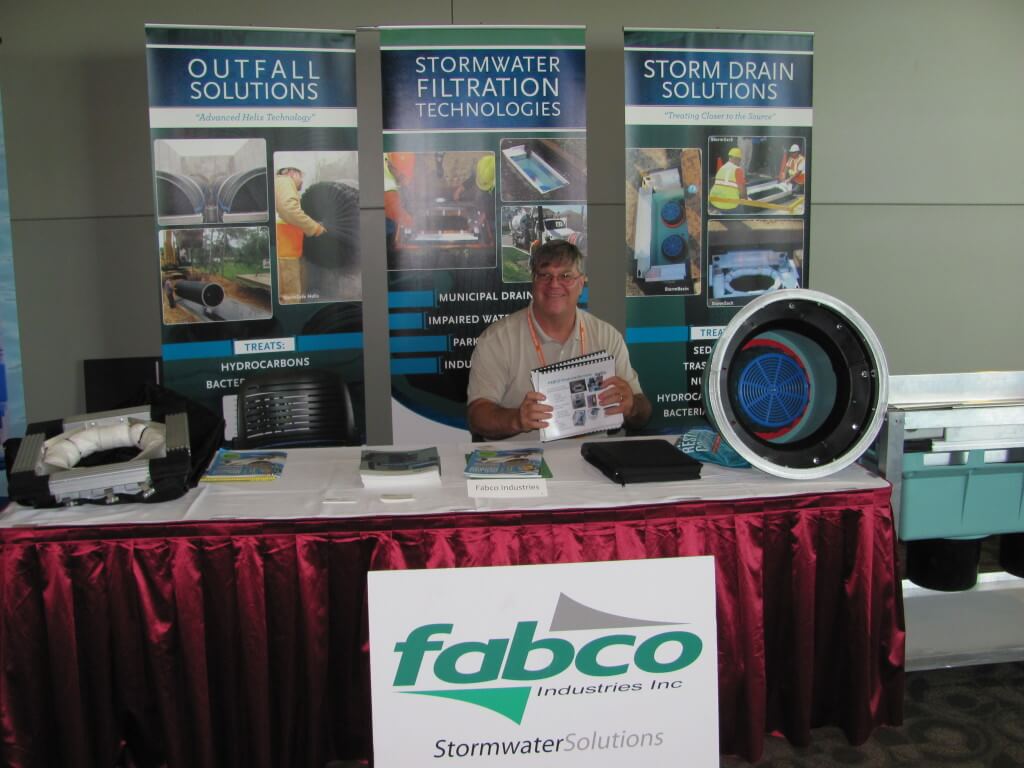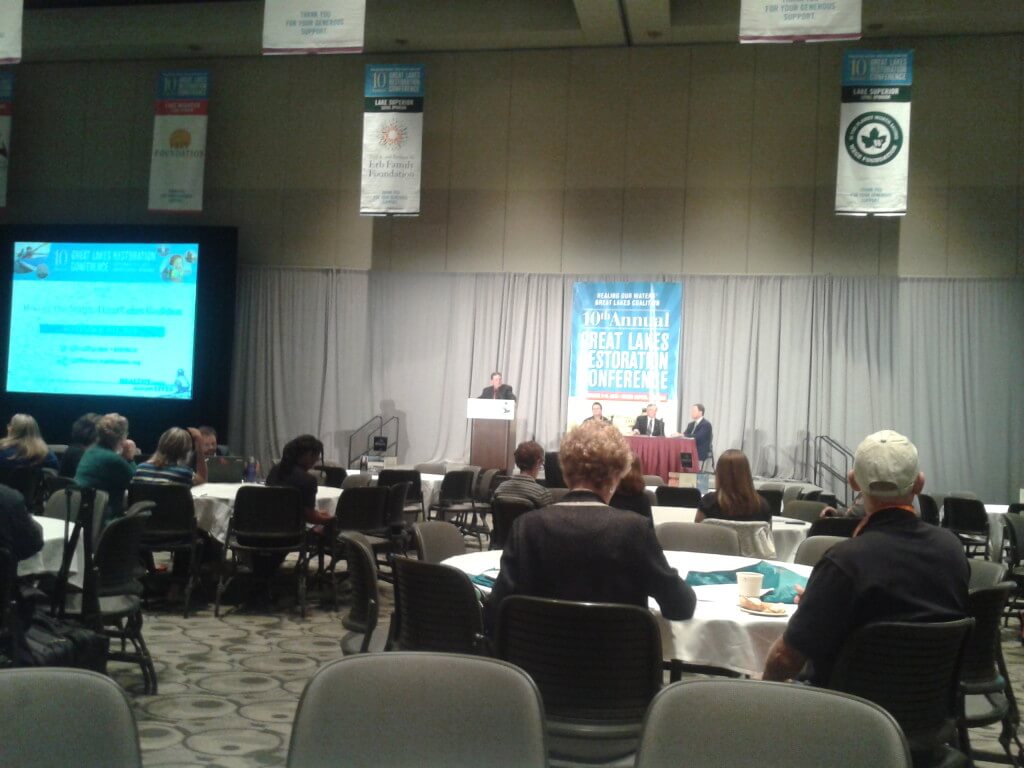Phosphorus Stormwater Reduction In Great Lakes Restoration
The theme of the event was phosphorus stormwater reduction. Fabco recently participated as a sponsor and exhibitor at the 10th annual Great Lakes Restoration Conference held in Grand Rapids Michigan organized by the Healing Our Waters- Great Lakes Coalition. The Coalition was formed in 2004 to unite diverse Great Lakes advocates, businesses and policymakers from the United States and Canada around a common goal of restoring the ecological health, phosphorus stormwater reduction and economic vitality of the Great Lakes basin, which some are calling the “water belt” of North America.
The Coalition is responsible for playing a major role in creation of the federal Great Lakes Restoration Initiative (GLRI) which has supported over 2000 Great Lakes restoration projects. Fabco has been a proud sponsor of the annual conference since 2011 and was pleased to exhibit and some of its innovative and cost effective filtration technologies for stormwater quality improvement including the StormBasin™ and StormSack™ catch basin inserts for retrofits and the Focal Point Biofiltration system for use in green infrastructure designs and applications in phosphorus stormwater reduction.

The advent of the growing problems with harmful algal blooms in Lake Erie and elsewhere in the Great Lakes region, as a result of excessive inputs of nutrients such as phosphorus stormwater reduction, is causing stakeholders including local governments, advocacy organizations and water dependent businesses to focus on strategies phosphorus stormwater reduction into water bodies and was a major topic of discussion at the conference.
A recent study of Lake Erie by the International Joint Commission on the Great Lakes, representing the governments of Canada and the United States, recommended phosphorus stormwater reduction of 40% from a variety of great lakes watershed sources including urban areas with large areas of impervious surface. To achieve these kinds of reductions will require strategies that utilize a variety of approaches including stormwater treatment.

Multiple conference participants expressed interest and surprise at the simplicity of design and ease of installation for Fabco products as a best management practice for stormwater. A common expression heard was “the more tools in the toolbox, the better.” Fabco looks forward to future endeavors with Great Lakes stakeholders to provide more of those tools for phosphorus stormwater reduction.
Phosphorus Stormwater Reduction Reference
Phosphorus (P) is a nonmetallic chemical element found in the environment that is an essential nutrient to plants in landbased ecosystems. While P is essential to terrestrial plant growth, it is often a pollutant in fresh-water ecosystems. As this nutrient is typically the ‘limiting nutrient’ to plant growth in fresh water systems (as nitrogen is to plants on land-based ecosystems) a small amount of P loading to a water body can elicit a rapid-growth response by algae.
Although P is not toxic to humans or aquatic organisms, once algae blooms occur in an aquatic ecosystem, the microbial decomposition of the algae causes aquatic microbes to utilize a higher percentage of the dissolved oxygen in water, thereby causing fish and other aquatic organisms to suffocate and ultimately die, often in large numbers.
This process is called eutrophication. Additionally, algae growth can blanket the surface of a water body, thereby reducing sunlight penetration through the water, resulting in reduction of photosynthesis to aquatic plants under the surface.
These aquatic plants are often habitat and/or food source for other aquatic organisms in the food web whereby reductions can lead to mortality of certain aquatic organisms or even whole trophic levels.
Phosphorus enters surface waters typically through non-point source stormwater runoff. It is either attached to sediment particles (particulate or sediment-P) or free-floating in the runoff water solution (dissolved or soluble-P).
Sediment-P runoff is typically higher where soils are disturbed, such as construction sites; while soluble-P is higher where land surfaces have been recently fertilized or where stormwater volumes are high due to prevalent impervious surfaces in the watershed – such as parking lots, highways, and roof tops.
Reducing phosphorous loads from runoff can be done by source reduction, reducing runoff volume (through infiltration or containment practices such as bioretention, engineered soils, and green roofs), or filtration (by physical means for sediment-P and chemical means for soluble-P). By the Numbers The total phosphorus concentration generally used for wastewater-treatment plant discharge limits is 5 mg L-1 (5 ppm), while typical urban stormwater-runoff concentration is approximately 0.4 mg L-1 (0.4 ppm).
The critical concentration of total P (sediment-P + soluble P) in streams at which eutrophication is triggered is 0.10 mg L-1 (0.10 ppm), and 0.03 mg L1 (0.03 ppm) for soluble P (Brady and Weil, 1996).
Soluble P entering surface water is of particular concern because it is often available to aquatic plants for immediate uptake, leading to increased risk of eutrophication, while sediment-P is not readily available for plant uptake (but can become available over time).
It is estimated that the total annual loss of phosphorus, nitrogen, and potassium due to soil erosion in the US is over 38 million Mg (42 million tons), and the annual cost to society is over $27 billion per year (Brady and Weil, 1996). In a 1998 water-quality assessment conducted for the US EPA, 35 percent of US streams sampled were found to be severely impaired while nutrient loading was the leading cause for 30 percent of those listed (US EPA 2000).
Streams designated for total maximum daily load (TMDL) compliance [Section 303(d) of the US Clean Water Act] for phosphorus pollution have become increasingly common in recent years. Over 5600 water bodies have been labeled as nutrient impaired and over 3500 have been designated as TMDL water bodies or segments for nutrients since 1995 (US EPA, 2007). While erosion and sediment control best management practices (BMP) may reduce sediment-P, they do little to reduce soluble-P in stormwater runoff.
Additionally, when soil becomes detached, sediment-P can quickly become desorbed, thereby transforming into soluble-P (Westermann et al. 2001). Where sedimentation is minimal, due to effective erosion control and/or permanently stabilized land surfaces, soluble P can be more than 80 percent of total P (Berg and Carter 1980).
In order to improve receiving water quality, and in particular to meet TMDL requirements for phosphorus, BMPs need to reduce soluble-P loading to streams. Soluble-P is more reactive, or bioavailable, relative to sediment-P to aquatic plants; therefore, it is more likely to cause algae blooms and eutrophic conditions contributing to the degradation of our nation’s surface water resources.
Green Solutions Compost Filter Socks Compost filter socks provide a physical means to filter sediment-P from stormwater, while the organic matter and humus fraction of the technology adds a chemical filtration component by chemically adsorbing soluble P ions in water.
According to research conducted at the USDA Agricultural Research Service (USDA ARS) with Filtrexx International’s FilterSoxx™, this technology removes 65 percent of total P and 27 percent of soluble P from stormwater runoff on disturbed or bare soils. By adding PhosLoxx™ to the technology, they reported that on fertilized soils, soluble-P removal efficiency from runoff increased to 92 percent.
Experimental conditions included runoffsediment concentrations of 60,000 mg/L, runoff total P concentration of 82 mg/L, soluble P concentration of 37 mg/L, and constant exposure to 30 minutes of simulated rainfall-runoff (Faucette et al, 2008).
Compost -Blankets Compost blankets, often referred to as compost erosion-control blankets or compost stormwater blankets, reduce P loading through site stormwater runoff volume reduction and because plant nutrients are organic (instead of mineral or Sustainable Land Development Today http://www.sldtonline.com Powered by Joomla! Generated: 8 March, 2011, 18:33 inorganic) – a form less mobile under storm runoff conditions relative to fertilizers typically used in traditional seeding and hydromulching applications.
According to research conducted at the University of Georgia (UGA) these compost technologies can reduce total P and soluble P loading in stormwater runoff by over 80 percent relative to hydroseed and hydromulch used in seeding and vegetation establishment applications (Faucette et al, 2005). Case Study: Lake Simcoe, Ontario, Canada The fifth largest lake in Southern Ontario, Canada, with a surface area of 720 km2, Lake Simcoe has elevated levels of phosphorus due to point and non-point source pollution from stormwater runoff.
The Ontario Ministry of the Environment has designated the lake as the future model in watershed protection and receiving water phosphorus reduction. The lake is home to approximately 400,000 residents and has experienced rapid development and urbanization in recent years. Currently, the lake receives an estimated 53 to 67 tons/yr of phosphorus.
The goal is to reduce P loading by 25 percent to improve end-of-summer dissolved oxygen levels in the lake using appropriate site design and BMPs. Under new regulations to improve and protect the lake, the provincial and federal governments are working together with a variety stakeholders.
A consortium, comprised of the Ontario Ministry of the Environment, Ontario Centers of Excellence, Environment Canada, Lake Simcoe Region Conservation Authority, Toronto and Region Conservation Authority, University of Guelph, Greenland International Consulting, the Cortel Group, Filtrexx Canada, and Filtrexx International, is collaborating on a research project to improve stormwater management practices for urban development sites.
Compost stormwater BMPs, with and without phosphorus-reducing agents, will be designed and installed for construction and postconstruction runoff phosphorus reduction.
A model development site will employ automated stormwater samplers to monitor and allow evaluation of the design and installation of these BMPs and the potential benefit they may provide to lake water quality. Case Study: Montpelier High School, Vermont The school recently increased the size of a one-acre, gravel parking lot to a paved parking lot just under two acres.
Tom Sabo’s Senior Biology Class and the school’s Earth Group student organization were concerned that the new parking lot would substantially increase phosphorus loading to the Winooski River, which drains directly to Lake Champlain. Lake Champlain has been well publicized as having elevated phosphorus levels due to urbanization and increases in impervious surfaces in surrounding watersheds.
The biology class was in charge of designing, specifying BMPs, and monitoring stormwater quality to control the anticipated elevation in runoff and phosphorus the new parking structure would generate. The class helped design and specify a Filtrexx bioretention and filtration cell system to capture and filter runoff from approximately 90 percent of the average annual rainfall using historical rainfall data.
Case Study: Bonnaroo Music and Arts Festival, Tennessee As one of the largest music festivals in the world, this joint venture between AC Entertainment and Superfly Productions attracts approximately 80,000 fans for four days to the 700 acre farm and venue where the festival is held.
Its managers are very committed to event environmental sustainability and have incorporated many sustainable practices, including, measures to conserve energy, carbon offsets through the Chicago Climate Exchange, preference for organic foods and catering, products and services provided by local businesses, recycling, and on-site composting. As part of the commitment to sustainability, managers contracted
Clean Vibes, a management company that specializes in reducing the ecological footprint of festivals and events, to help set up (among other things) a composting facility to recycle festival organic wastes. Filtrexx International Design Services was contracted to design a filtration cell to capture and treat stormwater runoff from the composting operation to reduce phosphorus and other potential runoff pollutants from leaving the site and entering nearby surface waters. Earthscapes of
Chattanooga, Tennessee installed the filtration cell. Phosphorus in stormwater runoff is one of the leading causes of surface water pollution in the United States. Stormwater reduction and pollution prevention using sustainable management practices and natural design principles is not only the future of this industry, but a win-win for all of us. SLDT

